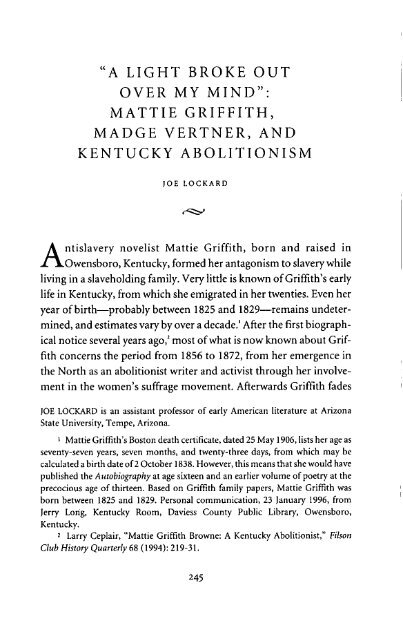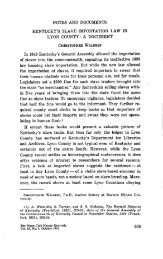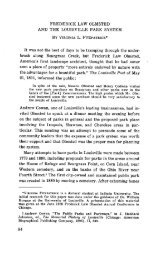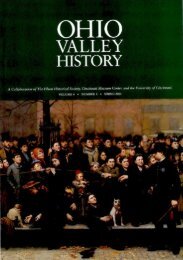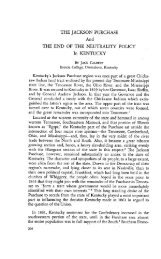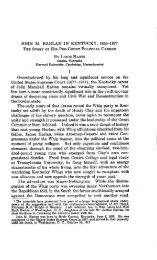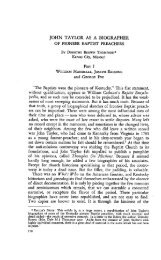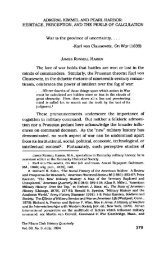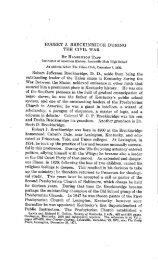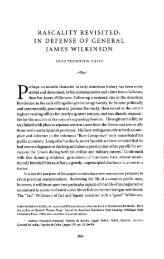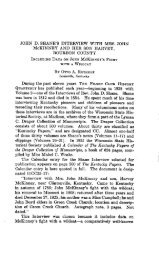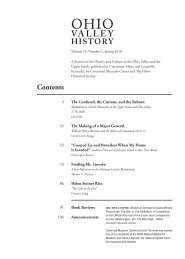mattie griffith, madge vertner, and kentucky abolitionism - The Filson ...
mattie griffith, madge vertner, and kentucky abolitionism - The Filson ...
mattie griffith, madge vertner, and kentucky abolitionism - The Filson ...
Create successful ePaper yourself
Turn your PDF publications into a flip-book with our unique Google optimized e-Paper software.
"A LIGHT BROKE OUTOVER MY MIND":MATTIE GRIFFITH,MADGE VERTNER, ANDKENTUCKY ABOLITIONISMJOELOCKARDntislavery novelist Mattie Griffith, born <strong>and</strong> raised inOwensboro, Kentucky, formed her antagonism to slavery whileliving in a slaveholding family. Very little is known of Griffith's earlylife in Kentucky, from which she emigrated in her twenties. Even heryear of birth--probably between 1825 <strong>and</strong> 1829--remains undetermined,<strong>and</strong> estimates vary by over a decade.' After the first biographicalnotice several years ago, 2 most ofwhat is now known about Griffitconcerns the period from 1856 to 1872, from her emergence inthe North as an abolitionist writer <strong>and</strong> activist through her involvementin the women's suffrage movement. Afterwards Griffith fadesJOE LOCKARD is an assistant professor of early American literature at ArizonaState University, Tempe, Arizona.Mattie Griffith's Boston death certificate, dated 25 May 1906, lists her age asseventy-seven years, seven months, <strong>and</strong> twenty-three days, from which may becalculated a birth date of 2 October 1838. However, this means that she would havepublished the Autobiography at age sixteen <strong>and</strong> an earlier volume of poetry at theprecocious age of thirteen. Based on Griffith family papers, Mattie Griffith wasborn between 1825 <strong>and</strong> 1829. Personal communication, 23 January 1996, fromJerry Long,Kentucky Room, Daviess County Public Library, Owensboro,Kentucky.2 Larry Ceplair, "Mattie Griffith Browne: A Kentucky Abolitionist," <strong>Filson</strong>Club History Quarterly 68 (1994): 219-31.245
THE FILSON HISTORY QUARTERLYinto an anonymous life in New York City until 1885 <strong>and</strong> afterwardsin Boston until her death in 1906.'Before leaving Owensboro, Griffith's antislavery views remaineda relatively private issue, apparently in part because of her family'sardent proslavery views. Her family's proslavery reputation reportedlyprotected Mattie Griffith <strong>and</strong> her sister Catherine when theywere brought before a county court for failure to supervise the slavesthey inherited from their father. If Griffith entered adult life hatingslavery as much as she reported, she nevertheless did not publishagainst it until after she left to live in Philadelphia around 1855 to1860. She never returned to live in Kentucky.' Mattie Griffith preferredthe life of a cosmopolitan reformer; Kentucky was the site ofher memories <strong>and</strong> fiction, whereas she lived most ofher life in northerncities.<strong>The</strong>re is at present no firm evidence to connect Griffith withother Kentucky abolitionists ofthe period when she lived in the stateor after she left. <strong>The</strong>re is, therefore, no way to position Griffith withinthe state's antislavery circles or to discuss her as a contributor to Kentucky<strong>abolitionism</strong>. Rather, Mattie Griffith was a singularity, a Kentuckyslaveholder who joined the inner circles of Garrisonian <strong>abolitionism</strong>in the North. Without intimate connection to any knownabolitionist activity in Kentucky, the historical discussion that remainsis to consider Griffith's fictions as an example of an angry antebellumreformer who chose exile from her home state. Griffithwrote against the literary tide ofthe southern domestic novel <strong>and</strong> thevoices of proslavery women writers like Caroline Hentz, MariaMcIntosh, Mary Virginia Terhune, <strong>and</strong> Augusta Evans.3 See Joe Lockard, Afterword to Griffith, Autobiography of a Female Slave(Jackson, Mississippi: University Press ofMississippi, 1998; originally published in1856), 403-418.4 Ibid., 413-16, for details of Griffith's life after leaving Kentucky.246
M ADGE VERTNERAlthough memories of its natural beauties colored Griffith'swriting, Kentucky held no social attraction for her. On the basis ofletters <strong>and</strong> internal evidence from her fiction, it is clear that Griffithlooked northwards for intellectual <strong>and</strong> political inspiration on slaveryissues. In Griffith's fiction, expression of antislavery sentimentinevitably comes from slaves, from characters connected with theNorth, or from sensitive white Kentucky youths doomed to expirehating slavery's rough harshness. A dominant motifofher two abolitionistnovels is a need to escape rural Kentucky, whether for Louisvilleor the North, in order to achieve freedom <strong>and</strong> opportunity. Failureto escape means enslavement or death. As the enslavedprotagonist of Griffith's first novel, Autobiography ofa Female Slave,exclaims when she leaves for the North: "I could but thank my Godthat I was leaving forever the State, beneath the sanction of whoselaws the vilest outrages <strong>and</strong> grossest inhumanities were committed!"This essay will examine Madge Vertner (1859-1860), Griffith'ssecond antislavery novel, as an exilic voice of Kentucky <strong>abolitionism</strong>.<strong>The</strong> novel speaks to many ofthe reasons why its author left Kentuckywith such antagonism <strong>and</strong>, given the declining death of the novel'sheroine, possibly suggests that Griffith believed that if she had notleft Owensboro her spirit might have died there too. Mattie Griffithwas a Kentucky novelist but no local patriot.Emancipation in the Kentucky WildernessMattie Griffith wrote Madge Vertner in Philadelphia between1857 <strong>and</strong> 1859 while chronically ill, profoundly depressed, livingin poverty, <strong>and</strong> supported by a private subscription circle? Hers Griffith, Autobiography, 398.6 This subscription circle, organized by Elizabeth Palmer Peabody on aquarterly basis, included herself, Lydia Maria Child, Charlotte Follen, MariaWeston Chapman, the Loring family, Albert Barnes, Ralph Waldo Emerson, <strong>and</strong>others. Griffith to Rebecca Spring, 7, 8 July 1857 <strong>and</strong> 23 September 1857. Rebecca247
THE FILSON HISTORY QUARTERLYprevious novel, Autobiography of a Female Slave, was a pseudoslavenarrative which described the trials of Ann, the mulatto heroine.Griffith's family objected deeply to its publication <strong>and</strong>, according tothe noted reform intellectual Elizabeth Peabody, made threatsagainst her divorced sister's child custody ifGriffith did not disavowthe book. After receiving a letter from Griffith, Lydia Maria Childwrote to tell their friend Louisa Loring that:She says friends are dropping away from her so on evelyside; abusive <strong>and</strong> insulting letters pour in uponher from all quarters; <strong>and</strong> being "delicately nurturedin an atmosphere ofbeauty," she feels so dismayed atgoing forth to battle with the world alone, that attimes she "longs for the repose of the grave."Although the Autobiography failed commercially, it brought herrecognition among abolitionists when she acknowledged her authorship.A review in <strong>The</strong> Liberator, probably written by WilliamLloyd Garrison, described Griffith as "a young lady of rare personalaccomplishments <strong>and</strong> ofbrilliant promise, who, ignorant ofthe radicalabolition movement at the North, out of the depths of her ownsoul" had written the Autobiography? As a reform novelist <strong>and</strong> abolitionist,Lydia Maria Child found that the Autobiography evidenced"greatness of soul, both moral <strong>and</strong> intellectual; <strong>and</strong> being written bya Kentucky woman.., it is an invaluable acquisition to our cause.'"Spring Papers, unreferenced, Stanford University, Stanford, California.7 Lydia Maria Child to Louisa Loring, 8 February 1857 in Patricia G. Holl<strong>and</strong><strong>and</strong> Milton Melzer, eds., Collected Correspondence ofLydia Maria Child, 1817-1880(Millwood, New York: Kraus-Thompson, 1979), fiche 35, letter 990.s Lydia Maria Child, "A Remarkable Work," <strong>The</strong> Liberator, 9 January 1857, p.8. For Child's later appreciation of Griffith, see "Lessons from Slaveholders,"NationalAnti-Slavery St<strong>and</strong>ard [New York City], 5 April 1862, p. 4.9 Lydia Maria Child to Sarah B. Shaw, 20 February 1857, Holl<strong>and</strong> <strong>and</strong> Melzer,Correspondence, fiche 36, letter 992.z48
M ADGE VERTNEROpinion in Kentucky was decidedly less favorable. According to theLouisville Journal:Considered merely as a literary production, independentof its gross misrepresentations, false theories,<strong>and</strong> most disgusting ultra anti-slavery aspirations,it evinces a high order of talent <strong>and</strong> literarygenius. We much regret to see a perversion of ability.We are pained to see a great genius thus grovelling inthe mire of fanaticism, <strong>and</strong> soiling its brilliant plumagein the filth of ultra <strong>abolitionism</strong>. •°<strong>The</strong> novel <strong>and</strong> news of its author's desire to free her slavesbrought a grant from the Anti-Slavery Society which enabled Griffithto emancipate <strong>and</strong> resettle her slaves outside Kentucky, north of theOhio River." In 1858 she returned briefly to Kentucky to do this. '2Having achieved a central goal ofher writing project, Griffith begana second antislavery novel. This novel, encouraged by northernadmirers, was serialized in the National Antislavery St<strong>and</strong>ard. WhileMadge Vertner uses many of the same sentimental devices found inthe Autobiography, its content differs substantially. Where the Autobiographyattempted to underst<strong>and</strong> the condition of blackness byadopting a slave's voice, Madge Vertner examines a white consciousness--afalsely white consciousness, it emerges--that gradually <strong>and</strong>fitfully gains awareness of racial privilege. In so doing, Griffith transformsthe Kentucky l<strong>and</strong>scape into a field of racial self-discovery.*0 Quoted in <strong>The</strong>Liberatar, 5 April 1862, p. 4.n Ceplair, "Mattie Griffith Browne," 224.t2 Griffith described the emancipation in a letter to Sydney Gay, a friend <strong>and</strong>editor of the National Antislavery St<strong>and</strong>ard; see Griffith to Sydney Howard Gay,dated "19th," no year [1858], Sydney Gay Papers, unreferenced, Rare Book Room,Butler Library, Columbia University.249
THE FILSON HISTORY QUARTERLYIf Madge Vertner's physical l<strong>and</strong>scape bears a heavy tint of romanticnostalgia for Kentucky's mansions <strong>and</strong> natural wonders, itssocial l<strong>and</strong>scape carries the charge of positive evil in the form of hum<strong>and</strong>egradation, slavecatchers pursuing runaways, <strong>and</strong> an internalmoral cancer created by slaveholding. <strong>The</strong> contradictions oftheir socialexistences as the beneficiaries of this society shape the fates of• Madge Vertner <strong>and</strong> her father, Colonel Andrew Vertner. Such contradictionslead Madge by the end of the novel to a sinking death, onethat derives more from alienation <strong>and</strong> anomie than from discerniblephysical causation, <strong>and</strong> one that deprives the Colonel of his closestlove. Griffith attempts to resolve contradictions through the conventionof the heroine's death, a staple of American sentimentalismsince Susanna Rowson's heroine Charlotte Temple died with suchpublic success. As both a beneficiary <strong>and</strong> an opponent of slavery,Madge Vertner is doomed by that contradiction; the impossibility ofits resolution in a slave society shaped the novel as clearly as it reflectedGriffith's own unresolved conflict between abolitionist advocacy<strong>and</strong> the received racial order. Indeed, the lack of resolution inboth the plot narrative <strong>and</strong> the author's ideology arguably providesthe entire novel with an energizing impetus.Griffith introduces Madge Vertner as a pure child of the Kentuckywilderness, a sixteen-year-old tomboy who defies gender expectationsin order to roam the forests together with her pony <strong>and</strong>dog. Colonel Vertner characterizes his daughter as "an independentlittle elf, as uncivilized as a bird or squirrel.... She is so natural.""Youthful years immersed in the forest serve to remove her from participationin the domestic economy of slavery, asthough such13 Griffith, Madge Vertner (hereafter MV), 10. Madge Vertner was neverrepublished after its initial serialization in the National Antislavery St<strong>and</strong>ardbetween 30 July 1859 (volume 20, number 11) <strong>and</strong> 5 May 1860 (volume 20,number 51). No page numbers are available for text quotations. <strong>The</strong> numbersgiven refer to the chapter numbers.250
MADGE VERTNERactivity separated Madge from the taint of full social awareness <strong>and</strong>guilty knowledge. <strong>The</strong> characterization also emphasizes her innocenceas a sentimental heroine, a position which removes her furtherfrom responsibility for her status as a member of the slaveowningclass. "Madge's life was as unconscious as that of the flowers," Griffitexplains, "She was blameless <strong>and</strong> guileless.""Her education is thin, for, as Madge complains, "Books arespeechless organs to me."" Her primary education derives from forestsrather than books; she appreciates practical botany <strong>and</strong> astronomyfar more than formal studies. Madge possesses "a clear, truemind <strong>and</strong> strong native underst<strong>and</strong>ing, uncolored or clouded by theory,dreams or speculation," a mind that could see "life <strong>and</strong> nature asthey were, not as other people represented them. '''6 Griffith createsthe character of an American practicalist, whose closeness to naturedifferentiates her from affected femininity <strong>and</strong> allows a closer approachto truth: "She said things rather than words."" Madge entirelyresists domestication: her room features portraits of Kentucky frontiersmen;its floors are painted with the figures of Indians, <strong>and</strong> firearms<strong>and</strong> a tomahawk hang on the walls. Her relationship with herfather is more akin to that of a son who enjoys a paternal indulgence<strong>and</strong> occasional companionship stalking through the woods. She hasonly a distant relationship with Mrs. Vertner, who has been alienatedby Madge's boyishness <strong>and</strong> patent rejection of conventionalfemininity.It is through a "feminine" pursuit of novel-reading, however, inthe form of Charles Reade's popular novel of English prison life <strong>and</strong>deportation to Australia, Too Late To Mend (1856), that Madge first14 Ibid., 9.15 Ibid., 1.16 Ibid., 13.17 Ibid.251
THE FILSON HISTORY QUARTERLYMattie Griffith BrowneCourtesy of <strong>The</strong> Trustees of<strong>The</strong> Boston Public Libraryquestions her terms of existence in a society built on captivity <strong>and</strong>discipline. Through Madge's logical comparison with the situationof two fictional white prisoners in Reade's story, she refuses to countenancethe continuing enslavement of two black slaves, Jack <strong>and</strong>Milly, whose escape plans she overhears while under the novel'simaginative influence. From this point forward her logic divergesfrom both Colonel Vertner's full participation in slavery's profitability<strong>and</strong> Mrs. Vertner's complaining exploitation of her householdslaves. A novel is the originating point of social subversion, <strong>and</strong> anovelist is consequently a potential subversive. When ColonelVertner discovers that his daughter was aware of the escape plans butrevealed nothing, he chastises her: "[Y] ou have acted very foolishly,but naturally for a girl that was excited by a novel <strong>and</strong>'could not discriminate;how could you run the parallel between my place <strong>and</strong> anEnglish prison? '''8 Madge's untutored logic grasps the parallel withts Ibid., 3.252
,i IL'•I' '11 •, ILl I' II1]i, t:'i L •1•'1 •
MADGE VERTNERfar more accuracy than the intellectual artifice with which the Colonel'slibrary reading provides him. This forest-born capacity for clearapprehension without formal education, for reading a democraticequality in the face ofsocial injustice places Madge Vertner in the receivedtradition of the Kentucky frontiersmen who decorate her bedroomwalls. <strong>The</strong> impulsiveness that governs Madge derives from herhonesty <strong>and</strong> penetration; she has not learned the artifices of concealmentthat formal education provides."Discovering" SlaveryGriffith posits a "natural" closeness between Madge <strong>and</strong> theblack slaves of her father's plantation, similar in constitution to herromantic closeness with Kentucky's natural environment. In Griffith'wishful construction, slaves recognize in her a figure of unmitigatedgood, an angelic wood nymph detached from her status as theplantation's young mistress. When Daniel, a house servant, eavesdropson a conversation with Mrs. Vertner in which Madge revealsher foreknowledge of the escape:[H]is great eyes gleamed with wonder as he listened,<strong>and</strong> what an angel did "Miss Madge" seem to his simpleheart! As she swept by him with the long train ofher riding habit dragging on the floor, <strong>and</strong> herplumed hat in her h<strong>and</strong>, he gazed after her withsomething like reverence; <strong>and</strong> the lips so used to thepulse of the heart broke out in a cordial, almost fervent,"Miss Madge. ''9<strong>The</strong>re is another "natural" order in such scenes, which is entirelysocial--a supposed inferior recognizing a supposed superior, one ofNature's nobility. Griffith structures a disconnection between19 Ibid., 4.253
THE F1LSON HISTORY QUARTERLYMadge, the slaves, <strong>and</strong> plantation ownership, whereas she is, in fact,one ofthe principal beneficiaries oftheir enslaved labor. Throughoutthe novel neither Griffith nor Madge expresses a realization that notonly must slavery be disavowed in order to achieve social equality butalso that the racial division of labor between master <strong>and</strong> slave mustbe eliminated to achieve that end. Rather, Griffith avoids such radicalconclusions through the ennoblement of an heroic individual conscience<strong>and</strong> the orchestration of an enslaved black consciousness intoan amen chorus.Madge is ofthe plantation but remains above it. As Madge arrivesat the slave quarter on a Sunday afternoon, Griffith describes a rusticfrolic where she appears "like a visiting angel. "• <strong>The</strong> environment ofthe quarter through which Madge walks does not bear excessivetraces of social realism; rather, the focus is on the slaves' adoring acceptanceof their owner's daughter. Since Griffith is engaged in elevatingMadge to abolitionist sainthood, she does not question theterms of this relationship between slaves <strong>and</strong> the plantation's youngmistress. Some twenty years earlier, English actress Fanny Kemblewrote in her journal with vastly greater realism ofher first visit to hernew husb<strong>and</strong>'s plantation slave quarters <strong>and</strong> of her reactions to itssights)' Although Madge's acts of care are not unlike those FannyKemble reported during these visits, the condescending tone of Griffith'language contrasts heavily with the wretchedness <strong>and</strong> completeabsence ofglorification in Kemble's narrative. This condescension isan artifact of the narrative requirements of sentimentalism in searchof a moral mission for a hero or heroine, a mission where moral superioritycan be evidenced before a canonizing denouement. As20 Ibid., 8.2• For Kemble's horrified description of a slave quarter, see her Journal of aResidence on a Georgian Plantation (New York, 1863), 30-34.254
MADGE VERTNERMadge Vertner walks through the quarter, she is being prepared forsuch elevation:As they skipped, shuffled <strong>and</strong> danced along, theirblack, shiny faces looked happier for the coming ofyoung mistress. As she passed gayly through, she hada word for each--some patronizing comment uponthe dance, some joke to give vent to. When she cameto an old or sick slave, she made kind inquiry after hishealth, or proposed some nice little remedy which hecould get by sending to the house; or, she drew fromher pocket a little roll of tea, sugar, or some such luxury,which she gave to him; <strong>and</strong> so her visits were alwayswelcome. •Madge Vertner plays Lady Bountiful from the Big House, fully culpablein slavery yet unaccountably innocent; she is granted immunityby virtue of inconsequential gestures. It is no surprise that foremostamong those who praise Madge as the exemplification of angelicqualities are Aunt Polly <strong>and</strong> Uncle Peter, aged <strong>and</strong> faithful servants tothe Vertner household. Madge addresses her family slaves either in alight, bantering tone or sits in sober contemplation of the thoughtsthey inspire; slaves are both entertainment <strong>and</strong> ethical inspiration.<strong>The</strong>re is a representational problem here for an abolitionistwriter, a problem created by using the slave-quarter description toflame Madge's virtues rather than the realities experienced by itsblack residents. How can widespread gaiety <strong>and</strong> welcome for a ministeringwhite "angel" coexist with the miseries of slavery? By carefulqualification, the social portrait Grifflth paints of life in the slavequarter emerges as one of silenced despair intermingled with occasionalpleasures. In lines preceding the above scene, Grifflth warns2• MV, 8.255
THE FILSON HISTORY QUARTERLYagainst favorable interpretations of such Sunday afternoon gaiety,beginning with an ill-chosen but characteristic trope: "Scenes ofanimallife <strong>and</strong> enjoyment such as these--little gleams of sunshine <strong>and</strong>pleasure in a world of blight--form the basis upon which certainwiseacres build up a wondrous superstructure of argument in favorof slavery.''2' A portrait of apparently happy slaves masking their unhappinessenables Griffith to reconcile the contradictions of suchscenes with her abolitionist antagonism. However, Griffith's focuson the ethical development ofthe "visiting angel" deprives her representationof black communal life of any meaning intrinsic to theslaves themselves. In this narrative regime, blacks exist for the moraledification of whites.<strong>The</strong> first major point of edification for Madge comes with thecapture of Jack <strong>and</strong> Milly, the runaway slaves from the Vertner plantation.During a meeting with the captured fugitives in the local jail,there is a dissonance between Madge's first momentary refusal to revealtheir escape plans <strong>and</strong> her now-stern rebuke, delivered while significantlytapping her riding whip. "How can you think papa will forgiveyou? It was very ungrateful ofyou <strong>and</strong> Jack....'2' Moved by theirvisible grief at the news that the Colonel intends to sell them,Madge's eyes moisten <strong>and</strong> her susceptibilities flow together with hertears. When she attempts to exercise her influence over ColonelVertner in order to protect Milly <strong>and</strong> Jack from sale to a slave-trader,who will resell husb<strong>and</strong> <strong>and</strong> wife separately "down the river," her fatherdeceives her with a false promise that he will agree to hire themout locally for a year. After Madge has left the prison, satisfied thather protective influence has been effective, Colonel Vertner remainsbehind to complete his intended sale.256
MADGE VERTNERThis encounter of naive sentiment with hard practicalism, whichappears throughout the novel, repeatedly ends with the victory ofpracticalism. Madge, however, still lives under the illusion that evenif they bear adverse financial or subversive social consequences, menwill honor their ideals or promises. She not only arrives at maturitywith a disabling naivete that prevents her from recognizing the termsof her existence, but she also continues to operate from the premisethat an honor informs slave-master relations even where hum<strong>and</strong>egradation manifests itself before her eyes. Madge Vertner is asmarginalized by her own failures of observation as she is by her dependentstatus as an immature woman. A mantle of legal legitimacycontinues to comm<strong>and</strong> her respect, largely through the respect sheaccords her father. By the time she learns, twelve chapters later, ofColonel Vertner's deceit, this long-attenuated respect collapsesaltogether.Blackness in CavesGriffith interwove Kentucky's racial politics <strong>and</strong> the social institutionof slavery with its natural features. An interlude of three chapters,twelve through fourteen, for a visit to the Mammoth Cave providesa lengthy opportunity for a discussion of these topics. Togetherwith her parents <strong>and</strong> closest friend, Helen Mason, Madge joins atourist excursion to a natural site that had become an increasinglypopular destination since the late 1830s, when Franklin Gorinopened the cave to the public <strong>and</strong> built accommodations at the site. 2•In having Madge <strong>and</strong> her companions visit Mammoth Cave, Griffithparticipates in an eighteenth- <strong>and</strong> nineteenth-century narrative traditionthat employed caverns as sites of wonderment, confused2s "Mammoth Cave," in John Kleber, ed., <strong>The</strong> Kentucky Encyclopedia(Lexington: University Press of Kentucky, 1992), 605-606; see also "StephenBishop," 82-83.257
THE FILSON HISTORY QUARTERLYEarly Mammoth Cave hotel managers <strong>and</strong> cave guides,including African-American guides Ed Bishop (first fromleft) <strong>and</strong> Bob Lively (first from right).<strong>Filson</strong> Historical Societyconsciousness, discovery ofhuman commonality, <strong>and</strong> natural exploration.26<strong>The</strong> descent of parties of white visitors into the darkness of thecave with the aid of black slave guides serves Griffith as a larger metaphor.Upon entering the cavern, racial roles of subordination <strong>and</strong>dependency are reversed--blacks make decisions <strong>and</strong> give instructionswhile whites have no choice but to follow. This situation producesa new sense of social equality, albeit a temporary one that lastsno longer than the duration of their underground visit. Griffith26 For more on this tradition, see Barbara Maria Stafford, Voyage intoSubstance (Cambridge: MIT Press, 1984), 112-24.258
IL]I ,• ' lu,h • .!L I IIIL! , I i ¸ •iIll, ;•li ] ] iIi• 'IIi, II I II, ih ! i I I• ¸¸ i , ,I,i ;I ¸¸ )I• i II UllI: ¸ ,• i I ¸¸I i,,Ii:•)! ¸ i,•Zl ........ ,,i • i•. •, •z:i ,•, ,• • •, , ,: l:uill,lll • •: iiii•, i, lil• ,UlJ i•,iI I•I•i ! t'•,;•[L1I)I,•Il I c LI
MADGE VERTNERobserves that "the most aristocratic ladies <strong>and</strong> gentlemen who visitthe Cave seem to forget for a time those unnatural distinctions ofrace <strong>and</strong> caste, <strong>and</strong> associate with the colored guides in the most familiarmanner9 Social barriers fall to such an extent here that it iswhere "for the first time in all her life Madge beheld her mother drinkfrom a cup <strong>and</strong> h<strong>and</strong> it to a negro. Truly, the Mammoth Cave shouldbe the temple of <strong>abolitionism</strong>. "2• Dependency under circumstancesof subterranean disorientation <strong>and</strong> risk generates fear, which in turngives rise to a willingness to accept equality. When Mrs. Vertner suggeststhat their guide Matt should not be enslaved, she later recantsher sentiments, saying, "Oh, I only said that because I was afraid ofthe negro. I didn't know what he might do with us 'way off in thatstrange, dark world. "• For black guides in this novel, the cave providesa temporary respite from racism, if not from slavery. <strong>The</strong>y areequal in the darkness, if not in the natural daylight of the surfaceworld. As Matt comments about his fellow guide, "Stephen says thisCave has been a world of comfort <strong>and</strong> pleasure to him. ''• <strong>The</strong> naturalwonders of Mammoth Cave constitute a refuge where black men'ssensibilities find unexplored territories. As they discover the featuresof the cave <strong>and</strong> lead white visitors to see them, they become empoweredagents rather than passive subjects.Mattie Griffith, whose relatively proximate residence <strong>and</strong> knowledgeof its interior detail meant that she had probably visited thecave, clearly based the novel's guides, Stephen <strong>and</strong> Matt, on StephenBishop <strong>and</strong> Matt Bransford. Whether from plot expediency or out ofconcern for legal complications, Griffith did not similarly nameBishop <strong>and</strong> Bransford's white owner, Dr. John Croghan (later, the27 MV, 12.28 Ibid.29 Ibid.30 Ibid.259
THE FILSON HISTORY QUARTERLYCroghan estate managers). Instead, she invented a fictional owner, alocal farmer named Sam Hemingway. Despite the quasi factuality ofthe novel's two guides, the remainder of the sentimentalized tragicpersonal history Griffith provides Stephen Bishop is dubious as morethan fiction. 3•In the 1840s <strong>and</strong> 1850s when Mammoth Cave tourism began itsfirst boom, Stephen Bishop was probably the best-recognized slavein the United States? 2 His renown as a guide was such that visitors3t Ibid., 14.n Stephen Bishop served as a guide for twenty-one years, accomplishing thefirst crossing of the Bottomless Pit, <strong>and</strong> he was the leading figure in the earlyexploration of Mammoth Cave. Bayard Taylor <strong>and</strong> other mid-nineteenth-centurytravel writers provide many accounts <strong>and</strong> references to Bishop, who impressedalmost everyone with his intelligence <strong>and</strong> style. Bishop achieved considerablenational <strong>and</strong> international attention from these reports. Griffitb, who hadapparently visited the cave <strong>and</strong> met Bishop, provides a heavily romantic personalreport. Possibly a more typical tone is found in a description, by turns appreciative<strong>and</strong> racist, from another visitor: "<strong>The</strong> guide is a negro, very gentlemanly <strong>and</strong>courteous in his bearing, full of wit, keen in his observations, <strong>and</strong> quite aphilosopher you will think, as he gives you his theories of the various formations,the bows <strong>and</strong> the whys <strong>and</strong> wherefores, interspersed with true nigger wit <strong>and</strong> fun.He has an elegant comm<strong>and</strong> ofthe language which would do honor to a member ofCongress." See G.S. Bailey, <strong>The</strong> Great Caverns ofKemucky (Chicago, 1868), 20-21.Descriptions of Bishop, whom visitors necessarily trusted with their lives in thecave, were consistent exercises of racial characterization in the midst of geologicalprose. See also Robert Davidson, An Excursion to the Mammoth Cave, <strong>and</strong> theBarrens of Kentucky (Lexington, 1840); Charles Wright, A Guide Manual to theMammoth Cave ofKentucky (Louisville, 1860), <strong>and</strong> Adam Binkerd, Pictorial Guideto the Mammoth Cave (Cincinnati, 1888). Frank Gorin, an early owner of Bishopbetween 1837 <strong>and</strong> 1839, takes credit for having brought him to the cave whileopening it as an early American tourist attraction: "I placed a guide in theCave,--the celebrated <strong>and</strong> great STEPHEN--<strong>and</strong> he aided in making thediscoveries." He continues: "Stephen was a self-educated man; he had a finegenius, a great fund of wit <strong>and</strong> humor, some little knowledge of Latin <strong>and</strong> Greek,<strong>and</strong> much knowledge of geology; but his great talent was a perfect knowledge ofman." Gorin discounts suggestions appearing in travel literature that Bishop washalf-Indian. He states that he knew Bishop's reputed white father <strong>and</strong> had owned260
M ADGE VERTNERfrom abroad wrote in advance to reserve his services, <strong>and</strong> he appearsin numerous travel accounts throughout these decades. Bayard Taylor,the leading American travel writer of the day, visited the cave inMay 1855 <strong>and</strong> toured underground with Bishop <strong>and</strong> Matt Bransford.Taylor adulated Bishop:Stephen, who has had a share in all the principal explorations<strong>and</strong> discoveries, is almost as widely knownas the Cave itself. He is a slight, graceful, <strong>and</strong> veryh<strong>and</strong>some mulatto of about thirty-five years of age,with perfectly regular <strong>and</strong> clearly chiseled features, akeen, dark eye, <strong>and</strong> glossy hair <strong>and</strong> moustache. He isthe model of a guide--quick, daring, enthusiastic,persevering, with a lively appreciation of the wondershe shows, <strong>and</strong> a degree of intelligence unusual in oneof his class. He has a smattering of Greek mythology,a good idea of geography, history, <strong>and</strong> a limited rangeof literature, <strong>and</strong> a familiarity with geological technologywhich astonished me?'Taylor continues to praise Bishop <strong>and</strong> concludes by stating that visitorsunder his guidance cannot avoid associating the cave withBishop's memorable personality.both Bishop's mother <strong>and</strong> brother. As his former owner, Gorin repeatedly usesextravagant praise to describe Bishop's talents. In 1839, Gorin sold Stephen Bishopto John Croghan together with the Mammoth Cave. See W. Stump Forwood, AnHistorical Narrative ofthe Mammoth Cave ofKentucky ( Philadelphia, 1870), 23-26.Bishop had become such a celebrity that when he died in 1859, the cave'smanagement erected a marble memorial tablet in his honor at the entrance to thecave. For more information on African-American Mammoth Cave guides, see alsoJeanne C. Schmitzer, "<strong>The</strong> Sable Guides of Mammoth Cave," <strong>Filson</strong> Club HistoryQuarterly 67 (1993): 240-58.33 BayardTaylor, AtHome<strong>and</strong>Abroad:ASketch-BookofLife, Scenery<strong>and</strong>Men(New York, 1870), 205.261
THE FILSON HISTORY QUARTERLYGriffith employs the gentlemanly <strong>and</strong> magnificent figure of theheroicized Stephen as a counterfoil to criticize precisely thephenotypical racism into which she herself frequently lapses. WhenMadge's friend Helen declares that, "You would scarcely take him fora mulatto or quadroon; he looks to me more like a h<strong>and</strong>some Spaniard,a Hidalgo, or a proud Mexican, with fine, straight hair, <strong>and</strong> deepelectric eyes,"" Madge responds by recalling the image of the fugitivelack in prison:He was not h<strong>and</strong>some, Helen; he did not look likeyour proud Mexican or Spaniards; he was a poor, ignorantblack fellow, who could not speak decent English,but he uttered some words that went direct to myheart?'Paradoxically, Stephen is one of two mulatto characters in thenovel--the other being Rachel----whom Griffith allows to voice atragic story of love frustrated <strong>and</strong> denied?6 Although the novel containsloving slave couples like Jack <strong>and</strong> Milly, Aunt Polly <strong>and</strong> UnclePeter, or the cook Hetty <strong>and</strong> town blacksmith Isaac, their affections<strong>and</strong> attachments are down-to-earth <strong>and</strong> voiced crudely rather thanthrough elevated expression.If Griffith-the-abolitionist explicitly rejects prejudice based onappearance as a condition for voicing ideals of freedom <strong>and</strong> equality,Griffith-the-novelist relies on phenotype as a dividing line betweenthe emotions of racial nobility <strong>and</strong> plebians. <strong>The</strong> mulatto conditionrepresents one where the freedoms of whiteness are almost withingrasp but still denied. Rachel voices the emotional predicament ofthis position when she says: "'I have no citizenship; ! am a mulatto•4 MV, 12.•5 1bid.36 Ibid., 14.262
MADGE VERTNERwoman, on a par with slaves <strong>and</strong> cattle (there was inconceivable anguish<strong>and</strong> bitterness in the tone.)"" <strong>The</strong> scarred emotional lives ofStephen <strong>and</strong> Rachel are the tragic products of almost-whiteness,whereas black slaves resist their objectification at more quotidianlevels: they either adapt <strong>and</strong> develop self-defenses or flee to theNorth. Griffith grants the novel's black slaves--particularly runawayslike Daniel <strong>and</strong> Maria--a monodimensional desire for freedom,together with a capacity to act upon that desire. Given herantislavery principles, she could hardly do otherwise. Yet Griffith'simagination of a full emotional life basically stops with the novel'stwo prominent mulatto characters; she does not cross the color lineto imagine a black emotional life as nuanced as her own.Beyond the association of a fully elaborated interiority withmixed-blood origin, physical attraction is repeatedly associated withmulattos like Stephen <strong>and</strong> Rachel, not with darker-skinned characters.Where Stephen has a "swarth, olive face, dark, flashing blackeyes <strong>and</strong> rough dress,"" Rachel is "one of nature's crowned queens.Tall <strong>and</strong> graceful of limb, with a smooth throat, erect head <strong>and</strong>drooping shoulders, she moved as gracefully as a swimming swan."'3By contrast, when the fugitive Maria makes her first appearance "awild, weird, black face looked in at the open window.., <strong>and</strong> a pair ofshriveled, claw-like h<strong>and</strong>s were stretched in supplication. "• Similarinstances of grotesque <strong>and</strong> distorted black features appear throughoutthe text, emphasizing Griffith's adoption of racial hierarchieswhere the mulatto serves as an ennobled middle stage of southerncivilization. <strong>The</strong> same hierarchical contrasts in appearance betweenmulatto <strong>and</strong> black appear in Autobiography of a Female Slave. <strong>The</strong>37 Ibid., 22.3s Ibid., 12.39 Ibid., 3.4o Ibid., 5.263
THE FILSON HISTORY QUARTERLYinherent grace <strong>and</strong> domestic poise of the Autobiography's mulattonarrator, Ann, compare favorably to her adoptive caretaker, AuntPolly," whose "dark, scowling countenance looked out from under asmall cap of faded muslin" <strong>and</strong> whose "little bleared eyes glared...with the red heat of a lighted furnace. '''2Griffith's manifest admiration of Stephen is only one instance ofher deep-rooted <strong>and</strong> apparently less than fully conscious habit of racialcharacterization, a narrative bias that remains oblivious to its effects.Indeed, without this racial structure of comparative praise, absenceof praise, <strong>and</strong> active dispraise, the novel would lose many of itsplot effects <strong>and</strong> political advocacy. In his mulatto attractiveness Stephenis a living argument in favor of a gr<strong>and</strong>eur that can be achievedthrough amalgamation or an example of the putative benefits ofadded whiteness. Stephen's masculine attractiveness, inventiveness,<strong>and</strong> adventurous personality class him with the "Spanish-looking"George Harris in Uncle Tom's Cabin:4t Both of Griffith's antislavery novels, Autobiography ofa Female Slave <strong>and</strong>Madge Vertner, feature an elderly black slave woman named Aunt Polly. <strong>The</strong>y arequite different characters. <strong>The</strong> Autobiography's Polly is disagreeable, dirty, <strong>and</strong>single but offers love <strong>and</strong> care when needed; Madge Vertner's Polly is likable,fastidious to the point of comedy, <strong>and</strong> married. <strong>The</strong> presence of two identicallynamed elderly black women raises the question of Griffith's purposes in this quitedeliberate choice. Possibly their presence derives from Griffith's own substantialexperience in households managed by older black women, where a real Polly mighthave been present in her life. Or were interchangeable older black domestic Pollyspart of a patronizing set of cultural naming practices, evident elsewhere in thisnovel (the slave boy named Pomp)? Lacking evidence to support the firstsuggestion, the second suggestion seems much more likely. <strong>The</strong> presence of pluralAunt Pollys in Griffith's antislavery novels underscores her use of stereotype in hercharacterization of black culture <strong>and</strong> persona. Griffith's use of stereotype extendsto whites too; both novels feature Yankee schoolteachers, Emily Bradly <strong>and</strong> JohnNorton, as inconstant abolitionists.42 MV, 3.264
M ADGE VERTNERFrom one ofthe proudest families in Kentucky he hadinherited a set of fine European features, <strong>and</strong> a highindomitable spirit. From his mother he had receivedonly a slight mulatto tinge..... [his] gracefulness ofmovement <strong>and</strong> gentlemanly manners had alwaysbeen perfectly natural to him."<strong>The</strong> racial romanticism that inflects such descriptions so heavily pervadesboth Uncle Tom's Cabin <strong>and</strong> Madge Vertner. Stowe advocatedthe Liberian colonization that Griffith explicitly rejected, <strong>and</strong> Griffitassociated herselfwith Garrison <strong>and</strong> immediatism. Despite thesevery different politics, however, both employed a positive white endowmentofmulattoism for heroic characterization. For Griffith, thebase st<strong>and</strong>ard for cultural judgment remains a norm of whiteness,even as she formally rejects that same st<strong>and</strong>ard.Slavery <strong>and</strong> Practical MenMammoth Cave provides more than a setting for racial interaction;it is also the beginning of Madge Vertner's romantic life whereshe meets <strong>and</strong> receives court from Mr. Butler, an English traveler. Itwas here also that Helen Mason, Madge's best friend <strong>and</strong> travellingcompanion, reveals to Madge that her affections now attach to JohnNorton, a new village schoolteacher from New Engl<strong>and</strong> who professeshimself an abolitionist. Both courtships proceed from sharedaversions to slavery. <strong>The</strong> most sensible elements of the new generation,Griffitb suggests, coalesce around mutual recognition of theunacceptability ofslavery. As these relationships develop, however, itis women who remain faithful to these ideals <strong>and</strong> men who ultimatelybetray them.4• Ibid., 12.265
THE FILSON HISTORY QUARTERLYMr. Butler recognizes the wrong of slavery as an abstract <strong>and</strong> endorsesantislavery principles from a st<strong>and</strong>point of economic modernization.For Butler, the most feasible plan "is to depreciate slavelabor.... Machinery is a more active <strong>and</strong> efficient Abolitionist thantwenty William Lloyd Garrisons. Supersede by machines the negroh<strong>and</strong>s employed in the culture of cotton <strong>and</strong> sugar, <strong>and</strong> you will havehalfstricken offthe bondman's fetters."" <strong>The</strong> progress ofmechanizationwill thus "pave the way for the introduction of a beautiful <strong>and</strong>unflinching morality.""Butler's economic <strong>and</strong> philosophical arguments against slaveryat first partially persuade Madge, whose response to slavery has inclinedto immediatist <strong>abolitionism</strong>. Madge, whose fate it is to remaintied to those with whom she disagrees, finds herself the fiance• of aman whose opinions she rejects. Butler's economic objection is ananathema to her more fundamentally human objections to the institution;in their respective persona, Madge <strong>and</strong> Butler incorporate thedifferences between gradualism <strong>and</strong> immediatism:<strong>The</strong> difference between her <strong>and</strong> him was that hethought, while shefelt; her dislike ofslavery was a passion,born in the very heat, intensity <strong>and</strong> redness ofher heart; while his was a calm thought conceived ofthe brain, matured <strong>and</strong> grown by long, timely <strong>and</strong>philosophical reflection; it had all the coolness, calmness<strong>and</strong> prudence of the head unfevered by theheart.•A sensory alertness to slavery's reality versus an abstract derivation ofantislavery principles is the difference between action <strong>and</strong> inaction.*4 Ibid., 14.45 Ibid.46 Ibid., 20.266
MADGE VERTNERThis difference is exacerbated by the capacity ofmen to take legalaction, whereas women have few or no rights ofproperty ownership,<strong>and</strong> their legal condition renders them incapable of steps towardsimmediate emancipation. Given such limitations, Madge readies themost effective weapon in her limited social arsenal--a threat to withholdaffection. As her abolitionist principles build, she reminds herfather that a "great principle" does not bend to family relationships:"'Forsake father <strong>and</strong> mother for Christ Jesus' sake.., <strong>and</strong> I think I amprepared to act upon it.""Unlike the women ofthis novel, men are inherently suspect as tothe depth of their political convictions against slavery. Male expressionsof antislavery sentiment are suspect either as mere wordsor--worse--a courtship strategy. <strong>The</strong> worst offender in this regard isJohn Norton, who courts <strong>and</strong> marries Helen Mason. When Nortonfirst meets Helen Mason, he declares himself a passionate abolitionist;he argues fiercely <strong>and</strong> successfully for a conversion of her conscienceon the issue. She tells Madge that "his mind, like a great lampswung up in the darkness of my life, has revealed to me the horrorsamidst which I dwell"" <strong>and</strong>, at her new fianc4's urging, she determinesto free her family's slaves. Helen braces herself in anticipationof adverse community reaction, but she is determined to make "anunflinching protest against the system. ''49 Madge <strong>and</strong> Helen form anoppositional dyad, sharing in the unpopular faith of immediatist<strong>abolitionism</strong>.Griffith, herself firmly associated with Garrisonianimmediatism, uses the appearance of gradualism to signal unfaithfulnessto <strong>abolitionism</strong> itself. When Norton qualifies his abolitionistargument, calling slavery "a huge, horrid Iniquity, which we cannot47 Ibid.4s Ibid., 24.•9 Ibid.267
THE FILSON HISTORY QUARTERLYstrike down at once, we must go cautiously <strong>and</strong> gradually to work,"Griffith depicts him as a compromiser who cannot confront the sinof slavery.• After Norton marries Helen <strong>and</strong> obtains control over herproperty, however, he quickly distances himself from the politicalfaith he has preached <strong>and</strong> uses gradualism as an excuse. Norton fullydeserves the cynical appraisal of townspeople who dismiss his <strong>abolitionism</strong>as show-talk <strong>and</strong> him as a fortune-hunter. Helen is a flailwoman who suffers from consumption, the same disease with whichGriffith killed off the sympathetic young John Peterkin, the plantationowner's young son <strong>and</strong> bearer of antislavery sentiments in Autobiography.By late in the novel, with Helen on her deathbed, Nortoncontinues to find excuses to delay emancipation, <strong>and</strong>, months afterher funeral, he drops all pretenses towards fulfillment ofhis promisesto liberate the family slaves. Instead, this once-abolitionist has beentransformed into a harsh <strong>and</strong> driving master whose slaves complainof ill treatment.Emancipation left promised <strong>and</strong> unperformed is emancipationdenied, <strong>and</strong> a male heart that does not underst<strong>and</strong> the cruelty of slaverycontinually finds economic reasons to leave emancipation in therealm of promises alone. Through the example of Norton, Griffithargues that the coercions of profit <strong>and</strong> loss are irrelevant within thecontext of divine recognition of individual souls <strong>and</strong> self-possession.Economic antislavery arguments, advanced by men with financialself-interests that generate deceit, ignore the central issue of freedom.Although luxury-loving society women like Mrs. Vertner, dependenton their husb<strong>and</strong>s for their indulgences <strong>and</strong> dependent upon blackdomestic labor for service, may endorse slavery, Griffith's "truewomen" have no need for these <strong>and</strong> can dispense with the system ofslavery. Madge is a stubborn child ofnature, convinced of the naturaljustice of her antislavery beliefs; Helen is eager to relinquish her50 1bid., 19.268
MADGE VERTNERpatrimony of slaves. In consequence, these two Kentucky women arethe only white characters in the novel who remain constant to theantislavery cause.Griffith views the world of Kentucky slavery as one built on malepower with resistance largely coming from Kentucky's black <strong>and</strong>white women. Of those in active resistance to slavery, four are blackwomen--Rachel, Milly, Maria, <strong>and</strong> Hetty; two are whitewomen--Madge <strong>and</strong> Helen; <strong>and</strong> two are black men--Jack <strong>and</strong> Daniel.When resistance leads slaves to flee or to seek a hideaway refuge,gentlemen slaveholders turn to the ungentlemanly domain of• slave-hunters, jailers, <strong>and</strong> traders to enforce its disciplinary system.Masculinity <strong>and</strong> masculine pursuits--especially commerce <strong>and</strong>hunting--maintain <strong>and</strong> enforce the slave system, whereas an independentfemininity undermines that system. Throughout MadgeVertner, men are a source of failure <strong>and</strong> domestic impurity; womensuffer the effects of these failures <strong>and</strong> seek corrective responses.Where Colonel Vertner participates in slavery <strong>and</strong> keeps his ownmixed-blood cousin Rachel as a concubine, Rachel <strong>and</strong> Madge maketheir contributions towards mitigating the system <strong>and</strong> suffer devastatingpersonal consequences. Where Isaac the blacksmith collaborateswith slave-hunters against fellow slaves, his wife Hetty undertakesthe risk of warning Rachel that danger surrounds her forproviding refuge. Women constantly seek to remedy a patriarchalslave system kept in place by male force, a force that remains unmovedby appeals of the heart <strong>and</strong> dismisses them as immatureeffeminacy.Together with the racial stereotypes that populate this novel,class stereotypes abound. <strong>The</strong> practical force for the maintenance ofslavery lies in a class ofpoor white men who aspire to wealth <strong>and</strong> thestatus of plantation owners. Griffith introduces members of thisclass--Captain MacFarl<strong>and</strong>, Tom Hynes, <strong>and</strong> John Sharpe---early inthe novel <strong>and</strong> intertwines them through the plot as the informal269
THE FILSON HISTORY QUARTERLYmilitia of slavery. Like blacks, Griffith defines poor whites as anunderclass through the use of vernacular. Unlike the sympathetic ifpatronizing representation of blacks, the social portraiture of poorwhite men is unrelentingly negative. <strong>The</strong>ir persistent motivation isgreed; their only discernible feeling is heartlessness. Whenslavecatcher Tom Hynes visits the Vertner mansion:How admiringly the vulgar man's eye w<strong>and</strong>eredabout, <strong>and</strong> occasionally lingered for a moment or twoupon some rich article of furniture. How he enviedthe owner of so much splendor <strong>and</strong> luxury, <strong>and</strong> perhapshe dreamed of the time when he too should bemaster of such an establishment."If Griffith values Colonel Vertner's gentility <strong>and</strong> makes occasionalpositive comment on his character, the men whom the Colonelemploys obtain no such grant of human decency. A class barrierdrops briefly whenever the Colonel <strong>and</strong> Tom Hynes meet, reappearingimmediately at the end of their discussion. However, the ironyharbored in lines such as "Business once arranged, the lordly gentleman<strong>and</strong> slave-holder dared not condescend to speak further with acontemptible slave-catcher "2 underlines Griffith's opinion of thefundamental inseparability of slaveholders, slave-catchers, <strong>and</strong>slave-traders. While the Colonel might feel "a sense of degradation ''•in the company of Hynes, he could not exhibit that feeling since, asGriffith writes with even more bitter irony from a woman involved inthe early suffrage movement, "the slave-catcher--degraded thoughhe be socially--has certain responsible political possessions; he is avoter---one of the Democratic sovereigns--<strong>and</strong> his existence cannot51 Ibid., 9.s2 Ibid., 3.53 Ibid., 9.270
MADGE VERTNERbe quietly wiped out or overlooked, as though he were a woman. "•Although a class barrier exists between the cosmopolitan Colonel,with his scholarly education <strong>and</strong> comfort with international visitors,<strong>and</strong> the provincial Hynes, who is most comfortable in the town bar,their common investment in slavery joins them in an interlockingpower structure.Associating provincialism <strong>and</strong> the governing class of local whitemen, Griffith looks towards a broader world for freedom <strong>and</strong> release.Abolitionism <strong>and</strong> schoolteachers come from the North; Madge'sprospective husb<strong>and</strong> comes from Engl<strong>and</strong>; slaves flee towards Canada.<strong>The</strong> small-town Kentucky milieu is intensely restrictive <strong>and</strong>antidemocratic, <strong>and</strong>, indeed, Griffith chose to live her later life inPhiladelphia, Boston, <strong>and</strong> New York.<strong>The</strong> novel's unnamed "dull <strong>and</strong> drowsy" nearby town of Lseems peopled largely with slave-catchers, drovers, <strong>and</strong> idle hangers-on,all with abundant time on their h<strong>and</strong>s to deal with any discontentedblack slaves. 55 On "court-days" farmers st<strong>and</strong> about "discussingpolitics, or settling, according to their own notions, some old<strong>and</strong> long-pending law suits; while tobacco juice <strong>and</strong> oaths flowed inplentiful streams. ''• <strong>The</strong> town's one saloon is the central gatheringpoint for an ill-educated class of"poor white trash" who flip coins ata young black slave woman willing to perform an erotic street dance.<strong>The</strong>mes ofsocial purity <strong>and</strong> temperance, central to Griffith's politics,manifest themselves in her antagonistic references to the local town.Nothing good emerges from it, only the suspicions generated by awhite underclass directed towards the surrounding rural aristocracy,their estates, <strong>and</strong> their slaves. Rachers cabin in the forest represents aminute foothold offreedom that comes under siege from townsmen54 Ibid.55 Ibid., 6.Ibid.271
THE FILSON HISTORY QUARTERLY<strong>and</strong> loses its sanctity once they enter. It cannot coexist with individualliberties; the town is a collective center from which surveillance<strong>and</strong> threats against freedom emerge. While Griffith's descriptions ofa provincial Kentucky town <strong>and</strong> its persona carry a ring of genuineobservation, they also echo with the language of degeneracy <strong>and</strong> internalcorruption with which northern abolitionist writers characterizedSouthern life. Lis not a town of orderly shops, towngreens, <strong>and</strong> white picket fences or the Stowesque stereotype that confusedneat New Engl<strong>and</strong> towns with democracy incarnate <strong>and</strong> civicvirtue rampant.Evangelical TranscendenceGriffith's estimate of the possibilities emerging from this worldare grim, <strong>and</strong> she is at a loss to explain how slavery could have entrencheditself so deeply in Kentucky society: "[W]e can only accountfor it by a belief in the doctrine ofutter Human Depravity," sheconcludes?7 Only one character, the slave Daniel, manages to escapeby fleeing for Canada; all others either remain unhappily or die. Inthis novel, internal attempts to change this society remain doomed tofailure; there is no domestic remedy. Confinement <strong>and</strong> imprisonmentemerge from <strong>and</strong> extend out from the institution of slavery toencompass all of society. <strong>The</strong> only means of transcending the confinementsof slavery <strong>and</strong> an oppressive local culture is religious faith.Her family's Catholic faith did not appeal to Griffith because theAmerican Catholic Church was ambivalent <strong>and</strong> institutionally inactiveon the issue of slavery. Instead, she turned to the evangelicalProtestantism that informed most of the abolitionist movement.Both in Autobiography <strong>and</strong> in Madge Vertner, Griffith adopts a passionateantislavery pietism, one that emphasizes the transformativepower of prayer to reconcile the suffering of this world with the57 Ibid., 14.272
M ADGE VERTNERpromise ofthe next. She emphasizes the role ofindividual conscienceas opposed to institutional dictate over the issue of slavery. Furthermore,she suggests that theological emphasis on reward <strong>and</strong> punishmentis basely inadequate in comparison to the "disinterestedheart-glow"•' which arrives with good deeds <strong>and</strong> justice. <strong>The</strong> abolitionistfirebr<strong>and</strong> <strong>The</strong>odore Parker observed in "A Lesson for theDay" that "Christianity has two modes of action, direct on the heart<strong>and</strong> life of a man, <strong>and</strong> indirect through conventions, institutions,<strong>and</strong> other machinery. "++ Griffith would have positioned herself <strong>and</strong>her fiction within the former mode, which Parker found desperatelyneglected.Madge Vertner, a creature of moral simplicity, lives in a minimallychurched state with an instinctual knowledge of right <strong>and</strong>wrong. To the extent that she has a developed moral philosophy, itcomes from life <strong>and</strong> discussion with her family slaves, where amongthem the "immortality of the soul form[ed] one of the chiefsubjectsofconversation in the slave cabins. "• <strong>The</strong> religious life ofblack slavesprovides Madge with inspiration for, as in one of Griffith's backh<strong>and</strong>ed<strong>and</strong> condescending lines, "Madge was not wont to confuseher mind with thought or speculation: she had been too active <strong>and</strong>happy for that; but one cannot live long among the lowly but suggestivenegro race without finding, at least, his imagination wonderfullyaccelerated. "+* Griffith inverts the racial hierarchicalism evident hereto suggest that the "lowly" enjoy, through <strong>and</strong> because oftheir humblestature, a closer relationship with the divine.For Griffith's abolitionist sensibility, black slaves had an unmediatedaccess to genuine religious experience whether throughss Ibid., 8.59 <strong>The</strong>odore Parker, Parker's Critical <strong>and</strong> Miscellaneous Writings (Boston,1856), 22.6o MV, 8.m Ibid.273
THE FILSON HISTORY QUARTERLYecstaticism in the quarter or quiet individual realization. For example,while sitting in jail after recapture, lack explains to Madge thatthe idea of freedom arose through divine revelation:[A]s I set thar working an' thinkin' side o' the fire, alight broke out over my mind, just as clar as day light,that I had no right to be given' all de strength thar wasin my marrow bones to any man--even if he waswhite. It seem to me as how God made me to ownmyself. 62With his classically phrased conversion testimony, one that invokesthe evangelical Christian image of light breaking overhead, Jack effectsa conversion of Madge to the cause of freedom; she leaves Jack<strong>and</strong> Milly's cell a freer soul than when she entered. Since the realmoral question centers on Jack <strong>and</strong> Milly's freedom, not that ofMadge, the piousness that Grifflth imbues into such textual momentsserves more for diversion of the narrative focus onto a whiteheroine <strong>and</strong> the edification of an implied white readership. <strong>The</strong> persistentabsence of the desired goal--freedom--leads to a theology ofdelayed reward, which in turn confirms the grim pessimism thatGriffith projects. It is precisely this acceptance ofdeath as the only racialequality achievable that Rachel states when she advises the fugitiveMaria that "the reward is to come after death. We will enjoyheaven more if we have had a hard time here. ''63In Griffith's narrative, an antislavery faith <strong>and</strong> true Christianfaith accompany <strong>and</strong> reinforce each other. <strong>The</strong> moments of greatesttrial <strong>and</strong> pain are equally the moments of greatest faith. Before Petergoes to receive thirty-nine lashes for aiding his wife Maria's escape,he counsels her, "We is jist got to walk up to dat whippin' post.., an'274
MADGE VERTNERthink'bout dat 'ar cross dat dey hung de good Lord on; an' I tells you,it'll make us forgit de pain. "" Having previously used public whippingas the consummate moment of faith <strong>and</strong> prayer for endurancefor Ann in Autobiography,+' in this novel Griffith relinquishes providinga lengthy religious prologue before the whipping scene <strong>and</strong> includesonly a contemptuous reference to "the most honorable <strong>and</strong>Christian law!"• When Lydia Maria Child commented that in MadgeVertner the prose style "has improved considerably'over the Autobiography,it is clear that Griffith's increased succinctness <strong>and</strong> deletionof thick paragraphs of passionate religious invocation found someappreciation. +7<strong>The</strong> architecture of faith followed by torture, so blatant in thewhipping passages of both these novels, represents an effort tocontextualize the pornographic quality ofdescribing a naked womanhung up for public lashing. In both novels, a beautiful near-whitewoman registers as the central figure of horror <strong>and</strong> shock over suchtorture, <strong>and</strong> she is the one able to translate the event into a transcendentmoment ofspiritual agony. Black torture victims live only at thelevel of their mundane pain; they are not primary models for thetranscendence of suffering. Griffith accepts a social valuation ofwhiteness as an erotic focus point <strong>and</strong> as a suitable agency for divinemediation. Rachel <strong>and</strong> Ann's nude <strong>and</strong> bloody near-white bodies,sustained in their shame only through the deliverance of prayer, becomean eroticized abolitionist argument in their own right. Griffith,who twice repeats this scene <strong>and</strong> the racialization of its central persona,is unable to resist the force of its appeal. <strong>The</strong> pain of blackIbid., 28.65 Autobiography, 46-49.66 MV, 29.•7 Lydia Maria Child to Oliver lohnson, 20 December 1859, Holl<strong>and</strong> <strong>and</strong>Melzer, ed., Correspondence, fiche 42, letter 1153. See Ceplair, "Mattie GriffithBrowne," 226.275
THE FILSON HISTORY QUARTERLYbodies, which appears with regularity throughout the two novels, becomesan occasion for sympathy for subordinates rather than a signofennoblement. Black slaves facing the lash might be sustained by orrepeat the terms of their received Christian faith, but they are not theoriginators of their own faith.If racial hierarchies remain embedded in Griffith's narrative onone h<strong>and</strong>, she emphasizes an equality of souls on the other. 6' Griffithparodies a religious system that can proselytize black slave congregantsas having souls in equal need of salvation <strong>and</strong> still distinguishsalvation <strong>and</strong> fellowship along racial lines. As one Baptist informsanother white townsman, "Brother Downes allers baptizes the whitesfirst, an' the niggers afterwards; an' that's right you know." <strong>The</strong>Griffith shared this twin belief in racial hierarchicalism <strong>and</strong> equalitybetween races together with major figures in the abolitionist movement. <strong>The</strong>odoreParker, for whom Griffith expressed admiration in the Autobiography, in an 1856speech before the general session of the American Antislavery Society rankedhuman development in a pyramid ofprogress. Caucasians had "advanced furthestin the development ofthe human faculties, <strong>and</strong> in the acquisition of power over thematerial world" (41); of Caucasians, the Teutonic family had advanced furthest(42); <strong>and</strong> of Teutonic people, Anglo-Saxons--particularly "that portion thereofsettled in the Northern States of America" had attained "the greatest materialcomfort, enjoyment of natural rights, <strong>and</strong> development of the human faculties"(ibid). Furthermore, Africans are characterized by the "ethnological misfortune"of a general racial sluggishness (48). Parker's racial hierarchicalism coexists withhis dem<strong>and</strong>s "to end this wickedness of slavery" (10) <strong>and</strong> for a state that will"secure to each man his natural <strong>and</strong> unalienable Rights" (11). See Parker's <strong>The</strong>Great Battle Between Slavery <strong>and</strong> Freedom (Boston, 1856) for the quotes above. Tobridge these separate positions, Parker argued that a "Progressive Force" ofhistorymust overcome a "Regressive Force" <strong>and</strong> that the abolitionist movementrepresented the vanguard ofthis social struggle. By drawing an American color linecarefully through social materiality <strong>and</strong> ignoring the share of black slave labor incapital accumulation, Parker legltimized a racial hierarchy <strong>and</strong> reconciledtemporal inequality with spiritual equality. Similarly, Griffith largely overlooks acritique of capital accumulation under slavery other than to suggest that it willhave no effect in terms of Final Judgment, which concerns spiritual worthinessalone.276
M ADGE VERTNERslave-catcher Captain Mac replies, "I ain't so sure ofthat, Sam Bosby;ifyou baptizes a nigger at all, I think he should be dipped longer thanthe rest of you. If you give him the right h<strong>and</strong> of fellowship, do it inthe clean way."°9 Inherent in this parody is a recognition that an admissionof equality in faith leads inevitably to similar recognitionthroughout society's domains. <strong>The</strong> dynamic ofone domain of recognizedequality creates a diminution, <strong>and</strong> then eventual collapse, ofblack-white binarisms.Similar instances of antagonistic parody become a means of argumentfor Griffith, one where she illustrates the inherent illogic ofinequality through reference to tenets of Christian faith. For example,in an exchange that Griffith footnotes as having been a literalconversation with a slave, Madge assures the houseboy Pomp that hewill go to heaven if he is a good boy. Pomp is at first attracted to theidea but then rejects heaven, saying:"But laws! Miss Madge, de kitchen an' de quarterwon't be nice, an' I'll hab to go in dar 'long wid deoder niggers.""No, if you are good when you die, you will go toheaven, where ther will be no kitchen, <strong>and</strong> all thesaved souls will live together.""Den dey ain't gwine to hab a kitchen up dar? And dewhite folks will go 'long de niggers? Oh no, MissMadge, God ain't gwin to hab no sich house as dat. ''•By suggestively transferring temporal arrangements under slaveryinto a vision of heavenly afterlife, Griffith ridicules a spiritual restatementof slavery for its illegitimacy. <strong>The</strong> logic of a material/spiritualdualism, where temporary materiality will disappear <strong>and</strong> leave only69 MV, 6.70 Ibid., 9.277
THE FILSON HISTORY QUARTERLYeverlasting spirit, demolishes a black/white racial binarism. In the instancesof white-to-black spiritual instruction scattered across bothof Griffith's antislavery novels, nearly all of them instances of Christianpatronization, she returns repeatedly to an insistence on spiritualequality based on immateriality of the soul. "God cares not, mychild, for clothes, or the color of the skin," the saccharine angel ofAutobiography, John Peterkin, tells a black slave boy, "He values theheart alone."' <strong>The</strong> child scoffs at this idea, replying that "you doesn't'spect a nigger's heart am clean, I tells you 'tis black <strong>and</strong> dirty as derefaces," <strong>and</strong> Master Peterkin rebukes him by saying, "Our dying Saviourembraced all your unfortunate race in the merits of his divineatonement.''2 While she unlinks physicality <strong>and</strong> the material conditionsof slavery from salvation, Griffith characteristically condescendsto the "unfortunate" black subjects of salvation. What herevangelical beliefs affirm, her adjectives deny.Madge Vertner's character reflects Griffith's evangelical <strong>abolitionism</strong>but also represents a considerable extension of that faith toexpress a Byronic identification of nature with divinity. Kentucky'swoods are a source ofromantic fulfillment, <strong>and</strong> as difficulties mountfor Madge, so does her desire to return to those woods. Outside nature<strong>and</strong> the forests, Madge is not her truest self; similarly, deprivedof their natural freedom, Madge implicitly underst<strong>and</strong>s, black slavescannot express themselves as God's true followers. For Griffith, astate of captivity violates a divinely ordained inner dictate of freedom.This principle of internal agitation towards freedom movesMadge <strong>and</strong> slaves like Jack, Milly, <strong>and</strong> Maria alike towards attainmentof freedom <strong>and</strong> consequently towards an underst<strong>and</strong>ing of divinegrace in the world.7• Autobiography, 1 13-14.72 Ibid., 114.278
M ADGE VERTNERAlthough at first glance such an embrace of Nature <strong>and</strong> its emotionalassociations might seem potentially agnostic, as nineteenth-centurycritics of English <strong>and</strong> American romanticism suggested,such is not the case here. Rather, in this motive for narrativeaction Griffith adapts the antislavery theologies of William ElleryChanning--<strong>and</strong> later <strong>and</strong> more forcefully, Wendell Phillips <strong>and</strong><strong>The</strong>odore Parker who described slavery as an impediment to therealization of God's gifts <strong>and</strong> so an offense in God's eyes. In wordsthat Griffith would echo twenty years later, Channing argued:[T]here is no [human right} which nature, instinct,makes so dear to us as the right of action, of free motion....Self-motion, this is what our nature hungers<strong>and</strong> thirsts for as its true element <strong>and</strong> life. In truth, everything that lives, the bird, the insect, craves <strong>and</strong> delightsin freedom of action; <strong>and</strong> much more must thisbe the instinct of a rational moral creature of God,who can attain by such freedom alone to the properstrength <strong>and</strong> enjoyment of his nature."In this tradition of religious <strong>abolitionism</strong>, human rights were sacred"gifts of God, <strong>and</strong> inseparable from human nature."' A natural freedomresided within every soul, <strong>and</strong> a human being could not be deprivedof spiritual freedom without instigating rebellion. Griffith,whose early poetry was almost entirely nature poetry, responded especiallyto this theological hypothesis. <strong>The</strong> novel's plot <strong>and</strong> subplotscontinually reiterate this movement towards spiritual realization ofNature's call, whether through slaves fleeing northwards or souls departingheavenwards; all escapes respond to an inner natural call.73 William Ellery Channing, Emancipation (Boston, 1840), 38.74 William Ellery Channing, Slavery(Boston, 1836), 31.279
THE FILSON HISTORY QUARTERLYWhile endowed with a semblance of orthodox Protestant belief,Madge's religious beliefs derive from a complex mix of a naturalequality, an unsystematic assembly of theology, <strong>and</strong> an internal governanceby unmoderated feelings. When her emotional rebellionagainst slavery climbs <strong>and</strong> she lacks the intellectual <strong>and</strong> political vocabularyto expression her opposition, she tells Mrs. Vertner "I don'tknow what you call it; I only feel that it is wrong in the sight of Godfor my father or any one to hold such an amount of property, to livein such style, while hundreds are suffering for ordinary comforts. '''5Social philosophizing that debates proslavery <strong>and</strong> antislavery views isuninteresting; Madge cares most for an internal feeling of ethicaltrespass.Evangelical faith in a world to come becomes a nostrum <strong>and</strong>, exceptfor runaways, practical immediatism remains the political reserveofthe white world. Even while writing a novel that recognizes adeep-flowing will towards freedom among slaves, Griffith does notcredit their temporal faith in themselves. Insofar as any underclasswere to accept such a representational imposition, it would destroythat same will towards freedom. Under these circumstances, invocationofthe hereafter is no more than Griffith's lack ofa better alternative.Although it appears often, advocacy of positive faith is not thetrue novelistic strength ofMadge Vertner. <strong>The</strong> novel works far moreeffectively when it sets out to detail <strong>and</strong> demolish the matrix of lies<strong>and</strong> falsehoods that surround <strong>and</strong> maintain the system of slavery.Dying of Blackness<strong>The</strong> central lie that has enabled Madge's life, her whiteness, finallycollapses when Rachel, now mad <strong>and</strong> in rags, appears late in thenovel to tell Madge that she is her father's daughter by a quadroon7s MV, 28.280
M ADGE VERTNERwoman]' Already Madge has had a premonition of this moment in aconfused dream earlier where "an old, haggard, witch-like creatureemerged from some ofthe recesses of the woods" <strong>and</strong> carried her offto a dark den, saying, "You are not Madge Vertner."" Rachel revealsherself as the Colonel's cousin from the North <strong>and</strong> a blood-relationto Madge. She relates the story of how Andrew Vertner seduced her<strong>and</strong>, concealing his married state, induced her to come to Kentucky.Upon arriving, Rachel discovered that Vertner had a mistress, a quadroonwoman who was pregnant with Madge; nonetheless, out ofmisplaced love, Rachel remained as his second mistress. When a legitimateinfant half-sister of the same age died, the Colonel <strong>and</strong>Madge's real mother seized the opportunity to switch the illegitimateMadge. Madge's true mother is now dead, <strong>and</strong> the slave nurse whoconducted the switch was emancipated <strong>and</strong> sent to the North. Rachelis the only remaining witness <strong>and</strong> produces a testament from theslave nurse as evidence for her story.In the penultimate chapter, Madge confronts her father with hernew awareness that she is "here in this house only by courtesy, orrather by means of a base lie <strong>and</strong> a baser fraud. ''7• Once unshieldedfrom her true identity, Madge's fall is swift. She informs Butler bycorrespondence ofher discovery ofher origins <strong>and</strong> releases him fromtheir engagement. Butler, who once stated that while against slaveryhe could not marry a woman with even a hint of black ancestry, recedesinto silence in Engl<strong>and</strong>; Madge swoons in the declining illnessthat kills her. Her heart, which had been her guide through theworld, fails quickly. Madge Vertner dies of color, <strong>and</strong> death makesher white: "Again she closed her eyes. <strong>The</strong> whiteness of her face in-76 Ibid., 36.77 Ibid., 29.78 Ibid., 37.281
THE FILSON HISTORY QUARTERLYcreased."" Madge sees a final earthly vision of silver-winged angelsgathering at her bed, <strong>and</strong> they beckon her towards them to "floataway on soft, white clouds.''° Her grave is marked by "a white marbleshaft. "s' In the final paragraphs of the novel we learn that a broken-heartedColonel Vertner sometimes thinks of his promise to hisdaughter to emancipate his slaves but that self-interest <strong>and</strong> respectabilityprevent him from doing so. Similarly, Mr. Norton continuesto break his promise to his wife <strong>and</strong> keeps his slaves. As this realm ofbroken promises <strong>and</strong> whiteness continues to endure, Griffith enjoinsher readers in the final line of the novel--"Let all such as condemnthese two men remember to do their part to lessen such unjust powerby fighting a good fight <strong>and</strong> casting a true vote in 1860. ".2At last revealed as a tragic octoroon heroine, Madge Vertner joinsa significant body of similar heroines in the antebellum literature ofracial romanticism." Despite her antislavery sentiments, she remainsfundamentally ineffective. In her swift acquiescence to the "disaster"of discovering her real identity, Madge Vertner can be located togetherwith similar stereotypical octoroon characters who are disabledin relation to a slave society. Even as the authors who createdheroic mulatto women sought to obtain sympathetic readership79 Ibid., 38.so Ibid.81 Ibid.s2 Ibid.s3 For a review of "tragic octoroon" characters in antebellum literature, seeAnna Shannon Elfenbein. Women on the Color Line: Evolving Stereotypes <strong>and</strong> theWritings of George Washington Cable, Grace King, Kate Chopin (Charlottesville:University Press of Virginia, 1989), 1-12 <strong>and</strong> Judith R. Berzon, Neither White NorBlack: <strong>The</strong> Mulatto Character in American Fiction (New York: New York UniversityPress, 1978). For a further listing ofoctoroon <strong>and</strong> quadroon women in nineteenth<strong>and</strong>twentieth-century southern literature, see Patricia Sweeney, Women inSouthern Literature: An Index (New York: Greenwood Press, 1986), 101.282
MADGE VERTNERthrough their whiteness, they underwrote prevailing racial <strong>and</strong> genderhierarchies. Elfenbein suggests that:[T]he octoroon's passivity . . . promotes a malesupremicist concept of acceptable, docile, virtuousbehavior. Her failure to come to grips with herself orher situation after discovering her true identity allowsthe patriarchal order to prevail, since her salvationrests with the white males in the author's audiencerather than with the abolition of white male supremacy.•In Madge Vertner's case, the exercise of a masculinist sexuality uponracial inferiors produces the revealed terms of her existence. Moreover,Griffith's decision to center an abolitionist narrative on alight-skinned <strong>and</strong> "passing" mulatto protagonist, while it might advancethe antislavery cause, reinforced inequality at the same time.Madge <strong>and</strong> Rachel incorporate a tragic essence of the mulatto, onewhich suggests that their deaths are as foreordained by their innerselves as by the cruelty of their society. Madge dies less of organiccauses <strong>and</strong> more because she simply ceases to live in an inhospitableworld; she remains, however, her father's loving daughter to the end.After telling Madge the truth that unifies them, Rachel hangs herselfin the forest because her already-marginal life has been destroyed. Ascharacters, they become more useful to Griffith as flat emblems elaboratedfrom a cultural vocabulary of race <strong>and</strong> not as characters possessingan interiority beyond their raciality--their public usefulnessends, <strong>and</strong> so does the novel. Such an unsatisfactory surrender of liferepresents an inability to imagine life beyond the confines of"race."In Madge Vertner, Griffith participates in a stream of Americanfiction <strong>and</strong> poetry that has represented minority raciality or ethnicitys4 Elfenbein, Women on the Color Line, 5,283
THE FILSON HISTORY QUARTERLYas a potentially noble but degraded condition. Sympathy flows directlyinto condescension <strong>and</strong> patronization; sympathy embodies<strong>and</strong> reinforces social hierarchicalism. Since public sympathy simultaneouslycan create political conditions that support liberationalcauses, a contradiction lies structured within that emotion. A minoritysubjectivity or group that attracts empathy risks assignment to thepathetic, <strong>and</strong> an antiegalitarian tension exists between sympathy <strong>and</strong>pathos. Even as sympathetic representation arouses public concern,it presents its subjects as disempowered or culturally unable to shapetheir own future. In the absence of such a capacity for self-help, thisnarrative suggests, a better future must be created for the subjects ofsympathy. <strong>The</strong> degradation created by an imposed <strong>and</strong> false helplessnessbecomes integral to a racial or ethnic stereotype, one whichm<strong>and</strong>ates that a culture must be "raised" to whiteness. Griffith's repeatedadoption of mulatto <strong>and</strong> octoroon characters signs the directionof elevation. Implicit in this coloring of sympathy is a greatervaluation of tragedy in whiteness than in blackness. As SterlingBrown writes concerning this str<strong>and</strong> of abolitionist fiction, "a whiteman in chains was more pitiful to behold than the African similarlyplaced. <strong>The</strong>ir most impassioned plea was in behalf of a person littleresembling their swarthy proteges. ''+5Even as it sought to advocate for black slaves, the work ofGriffith<strong>and</strong> many other abolitionist writers subtly or openly degraded theirhumanity. This recognition does not invalidate or devalue their contributionsto <strong>abolitionism</strong>, a movement that as a whole constituted apassionate affirmation of humanity <strong>and</strong> laid significant organizational<strong>and</strong> intellectual foundations for American progressivism. It issobering to recognize that Griffith--who participated actively fors5 Sterling Brown, "Negro Character as Seen by White Authors," in lames A.Emanuel <strong>and</strong> <strong>The</strong>odore L. Gross, eds., Dark Symphony: Negro Literature inAmerica, (New York: Free Press, 1968), 158-59.284
MADGE VERTNERmany years at the leading edge of antebellum <strong>abolitionism</strong> <strong>and</strong> postwarsocial movements, <strong>and</strong> who emancipated her own slaves as anact ofconscience--still manifested so many deficiencies through heruse of stereotype <strong>and</strong> racial hierarchicalism. That Griffith, committedas she was to antislavery from the time she emigrated from Kentuckyto become an advocate of civic equality for blacks <strong>and</strong> women,could repeat these fallacies many times in the very imagination <strong>and</strong>structure of Madge Vertner, testifies to the complete penetration ofsuch racial imagery <strong>and</strong> ideologies. <strong>The</strong> fractured ideologies <strong>and</strong> humanoppositions created by the idea of"race" appear in the representationalstrategies of political progressives despite other strengths<strong>and</strong> truths in their advocacies. Even attentive consciences are butpartial; their faults inevitably emerge with history <strong>and</strong> retrospection.Heroism ultimately belongs to the suffering subjects of history, notto their storytellers. When William Wells Brown, a former slave himself,said, "Slavery never can be represented," he spoke with a voicethat Mattie Griffith attempted to possess but never could. •86 William Wells Brown, A Lecture Delivered Before the Female Anti-SlaverySociety ofSalem (Boston, 1847), 4.z85


